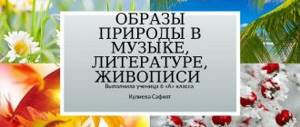Topic: “Images of romances and songs of Russian composers. Old Russian
— Guys, is it possible to supplement the exhibits of our exhibition with a musical instrument that will now be played?
Sounds r.n.p. “Thin Rowan” performed by guitar.
— What musical instrument did you sound? What can you tell us about him?
Children.
Stringed musical instrument guitar.
Teacher.
That's right, this is a guitar, a musical instrument known for a long time. The word "guitar" comes from the merger of two words: the Sanskrit word "sangita", meaning "music" and the ancient Persian "tar", meaning "string". (WRITE ON THE BOARD IN YOUR NOTEBOOK)
A guitar, an ancient musical instrument, appears at the exhibition.
— What are the names of vocal works for voice that are performed accompanied by a guitar?
Children.
Romance.
III. Explanation of new material.
Teacher.
You were introduced to the romance genre in 5th grade.
- Do you remember the origin of this word?
Children.
Romance is a name that comes from the Spanish word “romance”, which means Roman, that is, performed in the “Roman” (Spanish) language. This name appeared when so-called “secular” songs became widespread in Spain.
Unlike church chants, which in Catholic countries were always sung in Latin, “secular” songs were sung in Spanish.
Teacher.
What is this type of vocal music?
Children.
Romance is a vocal work for voice accompanied by any instrument - guitar, piano, etc. The romance sings of a great feeling - love, and with it the confusion of the soul and joyful excitement, the delight of meetings and the bitterness of separation, memories of the past and hope for happiness .
Teacher.
Until today's lesson, we had not thought that some romances are called ancient, while others are classical, or professional. Ancient romance arose before the classical one; its representatives were composers Alyabyev, Varlamov, Gurilev, etc. Ancient romance is a completely special genre with its own aesthetics. Performing ancient romances requires special skills, special mastery, which, as a rule, is not studied in conservatories. Even great singers faced this problem: Chaliapin, Obukhova, Nezhdanova...
They loved the old Russian romance by M. Glinka, N. Rubinstein, P. Tchaikovsky, Rachmaninov. They all found in it the most living and sincere language for the embodiment of love feelings, love culture. For the same reason, the ancient romance was and is loved abroad, finding in it one of the unique achievements of Russian music and poetry.
Ancient Russian romance is a whole layer of Russian musical culture. The melodies that were popular in those distant times have not lost their charm and pristine freshness today. It is difficult to imagine people who have not heard “Dark Eyes”, “Shine, Shine My Star”, “Wicket”, “I Loved You”, etc. Many Russian composers became famous for composing romances. Among them are composers that we will talk about today, you will hear their names later, but now read the text of the romance “Bell” by the Russian poet I. Makarov.
Page 1 of 3
We are already familiar with the romance genre as a type of vocal chamber music in which the lyrical side is clearly expressed.
The history of this genre is connected with the art of traveling poet-singers. The birthplace of romance is Spain. There, in the 12th-14th centuries, a new song genre arose in the work of traveling musicians, poets, and singers. He combined the techniques of recitative, melodic chants and mimic dance. The songs of the troubadour singers were performed in their native Romance language. This is where the name “romance” was born, which determined not only the special genre of the poetic work and performance traditions, but also the characteristic type of melody of a vocal piece performed accompanied by a musical instrument.
In the 15th century, with the development of lyric poetry, especially court poetry, the first collections of romances, called “romanceros,” began to be published in Spain. Over time, romance, drawing closer to folk art, acquired democratic features, but, unlike folk songs, retained the specificity of the genre. If the song could be performed either by a soloist or by a choir, accompanied by musical instruments or without them, then the romance was performed by one (less often two) singer and always with instrumental accompaniment: in court circles it was a vihuela, among the people - a Spanish guitar. Romance first penetrated into the countries of Western Europe as a literary and poetic genre, but later it was introduced as a musical genre, forming a vocal direction colored by national flavor in the music of different countries. In the 18th century, the romance genre also appeared in Russian music, becoming one of the remarkable pages of Russian musical art. The main ones are: a romance created by a professional composer based on the poet’s verses, and a romance created by amateurs, musically gifted people.
Professional romance was defined in the works of leading Russian composers of the 19th century; before that, romances were created mainly by amateurs. In the history of romance we find the names of famous figures of Russian culture, state dignitaries (especially in the 18th century).
V. Surikov.
Portrait of S. Kropotkina
For example, the music of one of the first collections of Russian romances based on poems by Russian poets was written by State Advisor Grigory Teplov. And much later, even in our time, romances continue to exist in these two main forms: professional
and
amateur
creativity.
A special branch was formed in Russia with the emergence of Russian folk urban song, in which the features of peasant song origins merged with the music of the city, forming a peculiar fusion of urban Russian, or, as it is often called, “everyday” romance
.
Representatives of this branch were talented musicians of the past Varlamov, Gurilev, Bulakhov
, who created romances in the Russian folk style, based on the words of folk poets or their own words.
- Remember A. Varlamov’s romance at M. Lermontov station “Mountain Peaks”
Alexander Varlamov
At the beginning of the 20th century, composers appeared who combined the intonations of Russian songwriting with the intonations and rhythms of gypsy songs, forming another branch of Russian romance with an openly sensual sphere of emotions, with sharply dynamic rhythms, and a tart modal-harmonic structure. Thus, we see how diverse the romance genre is; its examples often belong to the extreme poles of artistic creativity. The popularity of this genre to this day is explained by the embodiment within its framework of feelings that are very understandable and close to every person. Romances glorify love, and with it the confusion of the soul and joyful excitement, the delight of meetings and the bitterness of separation, memories of the past and hope for happiness.
The main genre features of romance
- The content of the romance does not go beyond the lyrics.
- The text is dedicated to a certain experience, usually love.
- Romance is characterized by only one lyrical mood. However, the range of emotional states in the romance is so wide that each performer and listener has the opportunity to choose the one closest to him.
- In a romance, the melody is more closely connected with the verse than in a song, reflecting not only its general character and poetic structure, but also individual images.
- Due to the fact that a romance usually expresses a love experience, it gives rise to one of the most important qualities of a romance - its intimacy and intimacy.
- Romance as a vocal and poetic genre is a three-faceted structure in which word, music and speech are equally significant.
Romance is also found in operas. For example, Antonida’s romance “I’m not mourning for that, my friends” in M. Glinka’s opera “A Life for the Tsar”.
“That’s not what I’m grieving for, my friends,
I’m not grieving because I feel sorry for the girl’s will,
That I will leave my father’s house.”
A.V.Nezhdanova as Antonida
The romance form also passed into instrumental music called “romancesansparoles” (“song without words”): it is a piece with a predominant melodic meaning. Such romances are written for piano (Tchaikovsky, Mendelssohn “Songs Without Words”) or for some other solo instrument with accompaniment (G. Sviridov “Romance” from the music to A.S. Pushkin’s story “The Snowstorm”).
Questions for consolidation (answer in writing in your notebook):
- Which country is the birthplace of the romance genre?
- Define the genre "romance"
- more in romances - music or text?
- In what centuries did the romance genre receive special recognition in Russia?
- What is the name of the variety of the “romance” genre, which was formed in Russia under the influence of the widespread use of folk songs in the urban environment?
- What are the main forms of romance in Russian music?
- Listen and name the piece (composer’s name, title)
- Listen and name the piece (composer’s name, title)
Let us remember that the romance genre appeared in Russia in the 18th century and became widespread in various social circles. The founder of Russian composer music, Mikhail Ivanovich Glinka, also made his contribution to the development of this genre.
Before reading one of his romances, watch a short film about Glinka’s life and work and answer a series of questions. Write down your answers in your notebook.
Video, part 1
Video, part 2
1. Where, when, in what family was M. Glinka born?
2. What shaped the character of little M. Glinka?
3. What kind of education did M. Glinka receive? (where did you study - in what city, in what educational institution)
4. In what department did you start working after graduation?
5. Where did you receive your musical education?
6. The first opera by M.I. Glinka. Its name. Date of the first production, in which theater it was staged.
7. The composer's second opera. Name.
8. What place did romances occupy in M. Glinka’s work? Write down the names of several of his romances (3-4).
9. Name what other works M.I. Glinka composed?
10. The creative fate of the composer: to what extent his music was known in Russia and abroad during his lifetime; what influence it had on the subsequent development of Russian culture.
- Back
- Forward >>
LiveInternetLiveInternet
Quote from Ninel_-_Nick's message
Read in full In your quotation book or community!
Romances and songs of Alexander Egorovich Varlamov.
On the birthday of the composer Alexander Egorovich Varlamov November 27, 1801, Orsk - October 27, 1848, St. Petersburg - Russian composer, bandmaster, singer, music critic.
Romances and songs by A. Varlamov are a bright page of Russian vocal music. A composer of remarkable melodic talent, he created works of great artistic value that gained rare popularity. Who doesn’t know the melodies of the songs “Red Sundress”, “A blizzard is blowing along the street” or the romances “A Lonely Sail Is White”, “Don’t Wake Her Up at Dawn”? As a contemporary rightly noted, his songs “with purely Russian motives became folk.” The famous “Red Sarafan” was sung “by all classes - both in the living room of a nobleman and in a peasant’s smoking hut,” and was even depicted in a Russian popular print. Varlamov’s music is also reflected in fiction: the composer’s romances, as a characteristic element of everyday life, are introduced into the works of many writers - N. Gogol, I. Turgenev, N. Nekrasov, N. Leskov, I. Bunin and even the English author J. Galsworthy. But the composer's fate was less happy than the fate of his songs.
Composer Alexander Varlamov was born on November 27
Varlamov was born into a poor family. His musical talent manifested itself early: he taught himself to play the violin and picked out folk songs by ear. The boy’s beautiful, sonorous voice determined his future fate: at the age of 9 he was accepted into the St. Petersburg Court Chapel as a juvenile singer. In this renowned choral group, Varlamov studied under the guidance of the choir director, the outstanding Russian composer D. Bortnyansky. Soon Varlamov became a soloist of the choir, learned to play the piano, cello, and guitar.
"Red Sundress"
In 1819, the young musician was sent to Holland as a choir teacher in the Russian embassy church in The Hague. A world of new and varied impressions opens up before the young man: he often attends the opera and concerts. He even performs publicly himself as a singer and guitarist. At the same time, by his own admission, he “deliberately studied music theory.” Upon returning to his homeland, Varlamov taught at the St. Petersburg Theater School, studied with the singers of the Preobrazhensky and Semenovsky regiments, then again entered the Singing Chapel as a chorister and teacher. Soon, in the hall of the Philharmonic Society, he gives his first concert in Russia, where he conducts symphonic and choral works and performs as a singer. In 1832, Varlamov was invited as an assistant bandmaster of the Moscow Imperial Theaters, then received the position of “composer of music.” He quickly entered the circle of the Moscow artistic intelligentsia, among whom there were many talented people, versatile and brightly gifted.
"I feel sorry for you"
“Music needs a soul,” wrote Varlamov, “and the Russian has it, the proof is our folk songs.” During these years, Varlamov composed “Red Sundress”, “Oh, it hurts, but it aches”, “What kind of heart is this”, “Don’t make noise, the winds are violent”, “What has become foggy, the clear dawn” and other romances and songs included in “ Musical album for 1833" and glorified the name of the composer. Working in the theater, Varlamov writes music for many dramatic productions. Varlamov was also interested in ballet. Two of his works in this genre - “The Fun of the Sultan, or the Slave Seller” and “The Cunning Boy and the Cannibal”, written together with A. Guryanov based on the fairy tale “Tom Thumb” by C. Perrault - were performed on the stage of the Bolshoi Theater. "Mountain peaks"
Throughout his life, Varlamov’s performing activities did not stop. He regularly performed in concerts, most often as a singer. The composer had a small but beautiful tenor in timbre; his singing was distinguished by rare musicality and sincerity. “He expressed inimitably... his romances,” noted one of his friends. Varlamov spent the last 3 years in St. Petersburg, where he hoped to again become a teacher in the Singing Chapel. This wish did not come true; life was difficult. The musician's wide fame did not protect him from poverty and disappointment. He died of tuberculosis at the age of 47.
"You are my darling"
The main, most valuable part of Varlamov’s creative heritage are romances and songs (about 200, including ensembles). The circle of poets is very wide: A. Pushkin, M. Lermontov, V. Zhukovsky, A. Delvig, A. Polezhaev, A. Timofeev, N. Tsyganov. Varlamov opens for Russian music A. Koltsov, A. Pleshcheev, A. Fet, M. Mikhailov. He is one of the first to turn to Lermontov; his attention is also attracted by translations from J. V. Goethe, G. Heine, P. Beranger. Varlamov is a lyricist, a singer of simple human feelings, his art reflected the thoughts and aspirations of his contemporaries and was in tune with the spiritual atmosphere of the 1830s. “Thirst for a storm” in the romance “The Lonely Sail Whitens” or the state of tragic doom in the romance “It’s hard, there’s no strength” are images and moods characteristic of Varlamov. N. Listova
Source: https://www.belcanto.ru/varlamov.html Variations on the romance “Don’t wake her up at dawn”
"Reminder"
"Don't sing, maiden soul"




